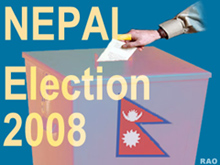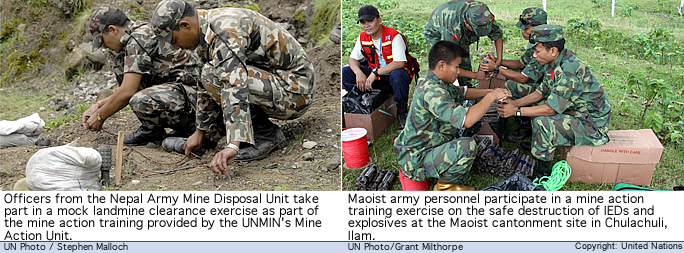UNMIN's
pre-election reports are posted on the Mission's website at www.unmin.org.np.
In its first report, dated 22 March 2008, UNMIN, while expressing concern
about increasing violence within the election campaign, noted that Nepal
is today better positioned than at any time since the signing of the Comprehensive
Peace Agreement (CPA) in November 2006 to hold a credible Constituent Assembly
election. In a second report, dated 30 March 2008, the Mission concluded
that campaigning continued in a relatively peaceful manner across much
of the country, but raised concerns about increasing violence, intimidation
and clashes between political parties in the context of the electoral process.
UNMIN has called on all parties to fully adhere to the electoral code of
conduct, and has called on forces tempted to disrupt the election to respect
the overwhelming desire of the people of Nepal, supported by the international
community, to see the election of the Constituent Assembly as the democratic
basis for determining the future of the nation.
UNMIN is a special political mission established by UN Security Council Resolution 1740 at the request of the parties to the Comprehensive Peace Agreement (CPA) signed on 21 November 2006, ending the armed conflict. The mission began its operations in the country in January 2007, and is headed by Ian Martin, the Special Representative of the Secretary-General (SRSG) in Nepal. Its mandate currently runs through July 2008. The mission's headquarters is in Kathmandu, with regional headquarters in Biratnagar, Pokhara, Nepalgunj and Dhangadhi. Currently, UNMIN has a total of just over 1,000 staff including some 186 arms monitors and 238 UN Volunteers. For several years before the establishment of UNMIN, the Secretary-General of the United Nations was closely engaged through the UN Department of Political Affairs, in efforts to encourage a peaceful resolution of the conflict. The Office of the High Commissioner for Human Rights (OHCHR) in Nepal was established in May 2005, with the aim of protecting human rights in the context of the armed conflict and threats to democratic rights. Since the May 2006 ceasefire, OHCHR has focused on monitoring human rights aspects of the peace process. The
UN Country Team in Nepal, coordinated by the UN Resident and Humanitarian
Coordinator, also supports the peace process. It includes the United Nations
Development Programme (UNDP), United Nations Population Fund (UNFPA), United
Nations Children's Fund (UNICEF), United Nations Information Centre (UNIC),
International Labor Organization (ILO) and World Food Programme (WFP),
and the Office for the Coordination of Humanitarian Affairs (OCHA) which
support and implement development programmes or assist in response to emerging
humanitarian needs.
UNMIN's Electoral Assistance Office support Nepal's Election Commission at the national, regional and district levels. The Mission has provided advice, as requested, throughout the different stages of the electoral process, on issues including voter registration, training of electoral staff, information technology, policy development, donor coordination, logistics and voter education. The UNDP has assisted the Election Commission with the establishment of the Electoral Observation Resource Centre to help support and coordinate observer groups. Prior to the Constituent Assembly election, UNMIN's District Electoral Officers will assist Election Commission officers in all the districts in the final preparations for and conduct of the election. Separately, an independent team of election monitors appointed by the Secretary-General, the Electoral Expert Monitoring Team (EEMT), has been making periodic visits to Nepal to review all technical aspects of the electoral process and conduct of the election. The EEMT will be present during the polls and the counting period. Its public reports are also available on UNMIN's website.
In early 2007, UNMIN military observers supervised the registration of Maoist combatants and storage of their weapons in cantonment sites around the country, as well as an equivalent number of Nepal Army weapons. They maintain a 24-hour presence at the seven main cantonment sites, as well as one Nepal Army barracks. The arms monitoring takes place under the terms of the Agreement on the Monitoring of the Management of Arms and Armies (AMMAA) signed by the Government and the Maoists in December 2006, and witnessed by the UN. In addition, ten Joint Monitoring Teams, each comprising one UN arms monitor, one member of the Nepal Army and one member of the Maoist army, conduct regular liaison, monitoring and investigation in the districts. In the lead-up to the election, UNMIN has strengthened its monitoring in all 28 Maoist army cantonments, as well as at Nepal Army barracks and installations. Arms monitors will be present at voting in all cantonment sites on election day. UNMIN has brought mine action experts from around the world to work with both the Nepal Army and the Maoist army to assist them in ridding Nepal of landmines and improvised explosive devices (IEDs), according to international standards in safe destruction procedures. UNMIN assisted the Nepal Army to develop a rapid response capacity to respond to reports of IEDs remaining in the community. UNMIN and UNICEF assisted the Government to establish a national authority on mines and IEDs under the Ministry of Peace and Reconstruction.
Civil
affairs officers carry out four main activities that are common to UN civil
affairs mandates: monitoring, reporting, liaison with State and non-State
actors, and good offices functions where requested and appropriate. Civil
affairs officers monitor the political space in the districts, in particular
the ability of all parties to campaign without intimidation in all parts
of the country. They travel throughout the country, and by their monitoring
and reporting, civil affairs officers aim to promote a free and fair atmosphere
for the election. UNMIN also has small teams of child protection and gender
advisers in the regions, who work closely with civil affairs teams.
The OHCHR in Nepal monitors and investigates human rights conditions throughout the country, including in the context of the electoral process, and also conducts legal analysis of policies and legislation. OHCHR also cooperates extensively with local and regional human rights organizations. The parties to the CPA expressly requested OHCHR to take responsibility for monitoring the human rights situation during the peace process, and UNMIN works closely with OHCHR in this regard.
top
The Comprehensive Peace Agreement (CPA) signed by the Nepali parties on 21 November 2006 ended a decade-long civil war that killed an estimated 13,000 people and resulted in 30,000 former rebels voluntarily entering into cantonments, the Nepal Army confining itself to barracks and the Communist Party of Nepal (Maoist) joining a coalition of originally eight parties (now seven) to form an interim government. One of the key requirements of the CPA is the holding of a Constituent Assembly election to determine a new constitution and restructure the state. The Constituent Assembly will also determine the future of the monarchy which has ruled Nepal for its 239-year history. The Constituent Assembly election will allow the Nepali people to elect representatives from political parties as well as independent candidates. Originally planned for June 2007, the election has been postponed twice. Following an agreement in December between the Maoists and the other parties of the Interim Government, the election was rescheduled for 10 April 2008.
Prepared by UNMIN, the UN Department of Political Affairs and the Peace and Security Section of the UN Department of Public Information.
|






